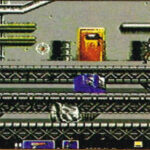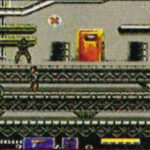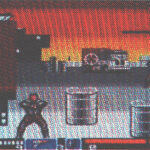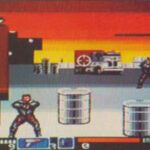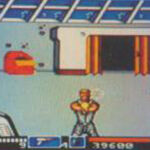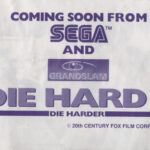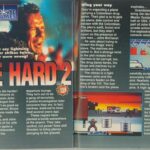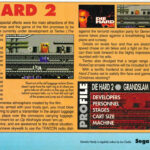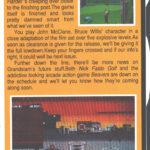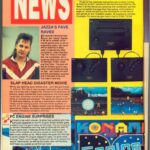1992 Grandslam
Platform: SEGA Master System
By the early 1990s, games based on movies were extremely popular – but there were a *lot* of duff titles in the mix. Die Hard 2 could well be considered to be among that list, though Grandslam were putting a lot of faith in the licence, with conversions to most major platforms – including a conversion to the SEGA Master System.
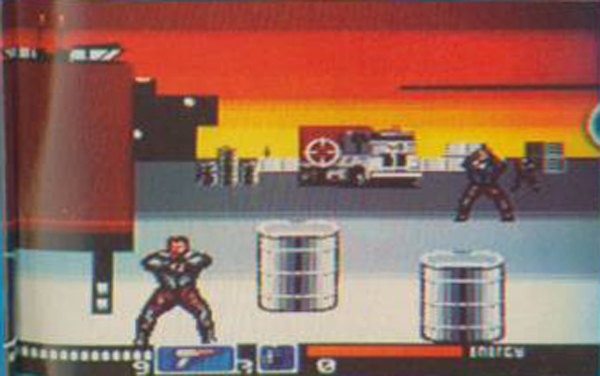
Grandslam had just recently got their break on the platform with the release of The Flintstones, so Master System owners could also ensure the pain of having to paint a wall for fun like I once did on the C64. Tiertex had converted that one for them, and they would also be entrusted with doing Die Hard 2 – of which they had carried out developments for the other platforms too.
The Master System game had seemingly been in development for some time, with an original release date slated for December 1991 according to issue one of SEGA Pro magazine. The game was even advertised within the manual of The Flintstones. Most versions of the game though wouldn’t surface until well into 1992.
SEGA Pro’s brief preview alludes to the fact that the game would contain digitized scenes from the film, with accompanying text to introduce each level. The game itself was based on Operation Wolf, where the first level would take place in the airport luggage sorting area – shooting various bad guys.
The next level has you going along the airport annex sky-walk to use the TRACON radio dish to transmit warning messages to the aircraft. Level three then has you fighting against the terrorist reception party for General Esperanza. Other levels were sketchy at this time, but there was to be around five in total.
There would be delays to development by Grandslam, which seemed to affect all developments. SEGA Force magazine released a Movie Games booklet in November 1992, which featured a larger segment on Die Hard 2, where they suggest the game would feature a high speed 3D snow bike chase and a special pre-combat training range.
Although SEGA Pro had suggested back in July 1992 that the Master System edition had been indefinitely postponed – SEGA Force were now suggesting that the game was still on and slated for release in early 1993. However, the apparent revival of the project was seemingly short-lived and the game would disappear without a trace.
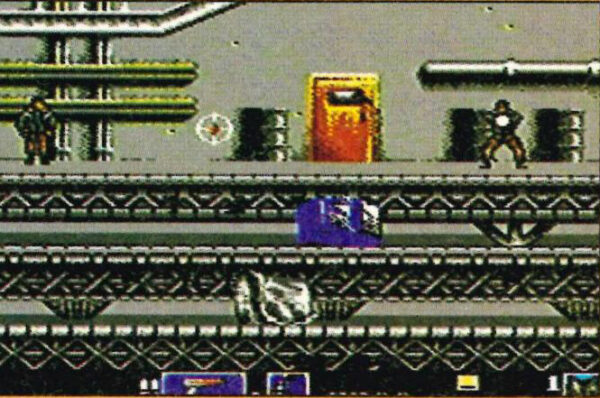
For years, Master System fans have been wondering exactly what happened to the game and who was behind it. Music and sound seems most likely to have been either John Hancock or Mike Davies, who were the main musicians based at Tiertex at that time, and had done music for the other platforms. But what of the developer and artist/s?
Whilst doing investigations into another unreleased Tiertex game (Mega Twins) several years back, it was revealed that the developer (or at least one of the developers) was none-other than Chris Shay. Chris had previous done 8-bit conversions of M.E.R.C.S for the ZX Spectrum and Amstrad CPC, and this would be one of his next projects.
Chris revealed that he had worked on the game back in the early 1990s, but also that it was fully complete – “at least to a final debugging stage”. However, it never got released for reasons currently unknown. Chris didn’t reveal why exactly the game never got out there, though it is thought to be due to concerns over the quality of the game. Sadly, Chris did reveal that he no longer had anything of the development.
We have tried to get back in touch again with Chris to learn more about who was involved on the game with him, especially regarding the artwork. We haven’t been able to get a response just yet – but once we learn more, then we’ll update this page with any further findings. We are also awaiting a response from a few others who worked at Tiertex.
Paul Cole (who worked on the C64 version) didn’t know anything about the conversion, though suggested it was very likely the same artist who did the C64 edition. He couldn’t recall the names though – but long ago we were informed by artist Simon Street that he was behind the C64 graphics, as well as doing the title screens on the Amiga, ST and C64 editions. We’ve reached out to Simon to see if he knows more.
Going back to Paul Cole – Paul felt that the game was probably cancelled due to SEGA not approving the title – but he hadn’t heard any reasons at Tiertex as to why the game was canned.
Developer Paul Gill remembered the development though, as Chris was sitting in the same room as him when he was writing the game. Paul had no idea that the game had got cancelled or why, and revealed that it wasn’t that bad at all, stating that Chris was a great programmer and one of the best he’d ever worked with.
Paul suggests it was perhaps around the same time he was working on Strider 2, which was also canned. He wonders if there was some kind of politics going on behind the scenes.
As for the chances of finding the game – with Chris no longer having, then it could be tricky to locate. Perhaps one of the artists may still have something of the game? Or could prototype copies exist somewhere still? We hope some day that this intriguing title for the platform can be saved.
With thanks to Maxim from SMSPower for the booklet scans, Paul Cole, Paul Gill and Chris Shay for information about the game, SegaRetro for the manual scan and Archive.org for the rest of the scans.
